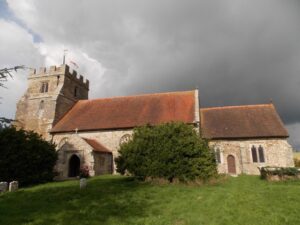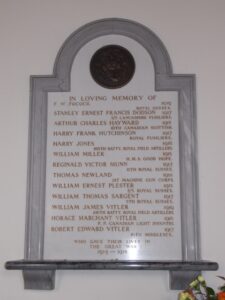 The first public mention of any type of tribute to be fitted in Hooe Church in memory of the men who had fallen in the First World War was in the Bexhill Chronicle, dated 23rd August 1919. It read:-
The first public mention of any type of tribute to be fitted in Hooe Church in memory of the men who had fallen in the First World War was in the Bexhill Chronicle, dated 23rd August 1919. It read:-
“War Memorial Tablet – It is proposed to erect a mural tablet in the recess in the north wall of the church to the memory of parishioners who fell in their country’s service in the Great War. A design for a marble tablet and estimates of the cost have been submitted by Mr Francis, of Station Road, Bexhill. The inscription suggested runs – “In grateful memory of the men of this parish who died for us during the Great War, 1914-1919. F. Clarke, C. Hayward, H. Hutchinson, H. Jones, W. Miller, W. Plester, T. Sargent, H. Vitler, R. Vitler, W. Vitler, V. Munn.” The Vicar, the Rev. C. Routh, “The Lodge”, Hooe, will be pleased to receive donations.”
Of this suggested list of the fallen, F. Clarke doesn’t appear on the finished memorial and, added, are the following five men, William Alfred Harden Dennett, Francis Ernest Stanley Dodson, Thomas Newland, Thomas George Noakes, and Frank William Pocock.
The original design for the memorial was produced by the artist Alfred Robert Hayward, a well-respected painter in oils at that time and the brother of Charles Hayward, one of the fallen on the list of names.
 Subscribers came forward to make donations to the fund and more than enough money was raised to allow the committee to move on to the next stage. So, on Wednesday 24th March 1920 a parish meeting was held in the village hall where all the villagers were invited to come along and discuss the question of the memorial and to ensure that all were happy with what had been proposed. Some changes were made in the design, and a second estimate was asked for from R. Francis & Sons.
Subscribers came forward to make donations to the fund and more than enough money was raised to allow the committee to move on to the next stage. So, on Wednesday 24th March 1920 a parish meeting was held in the village hall where all the villagers were invited to come along and discuss the question of the memorial and to ensure that all were happy with what had been proposed. Some changes were made in the design, and a second estimate was asked for from R. Francis & Sons.
When the final design and all the costs had been agreed and accepted, a ‘Faculty’ had to be obtained from the Bishop of Chichester, before any work on the fabric of the building could proceed – and fitting a memorial to the wall came under this requirement. This was granted on 18th July 1923 and things quickly moved to the next stage.
Having got permission to go ahead with the memorial, R. Francis & Son produced the memorial and had it fitted by the end of August 1923. More than enough money had been raised from subscriptions to cover the costs of the memorial and its installation in the church, so there was some to spare and the “Bexhill Observer”, on the 28th June 1924, reported on a meeting held to discuss what to do with what was left over. The report appears below:-
“War Memorial – A meeting of the subscribers was held in the School. The Vicar, who was elected to the chair, stated that the proposal, carried at the last meeting to use the balance of the money for the direction of a shelter at the Common was negatived by the Rural District Council. The Secretary’s letter to this effect was passed round the meeting. A motion proposed by Mr Newport and seconded by Mrs Freeman, to erect an oak shelf for flowers under the Memorial was carried unanimously; and after some discussion, on a motion by Mr J Luck, it was decided to give the balance to the Church Organ Fund. Attention was drawn by Mrs W Munn to the omission of a name on the Memorial, and the meeting decided that steps should be taken to see whether this could be rectified. The expense was to be borne by the fund. After a statement by Miss Hayward, of the history of the fund, the choice of the Memorial and its position, showing that the wishes of the majority of the subscribers have been carried out, the meeting closed.”
The receipt for payment received, by R Francis & Son, gives the description of the memorial, as follows:-
“War Memorial, Hooe Church
To White Carrara Marble Tablet with Dove Marble surround with ditto Vase Shelf and Corbels surmounted with solid Bronze Medallion of St George and Dragon with Inscription and Names of Heroes engraved and gilded all fixed in the Church as the estimate.”
The cost in October 1923 was £53 10s 0d. Today this would be roughly £2,713.

